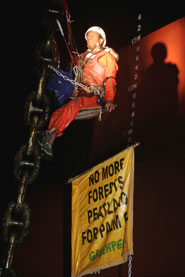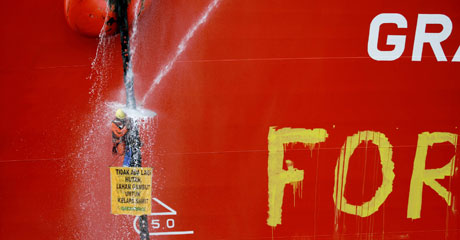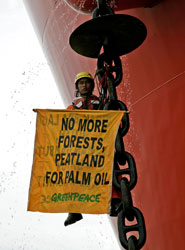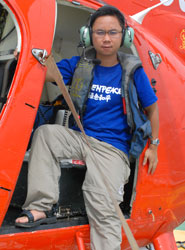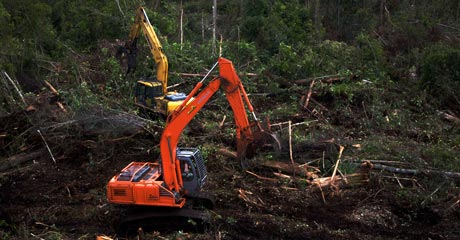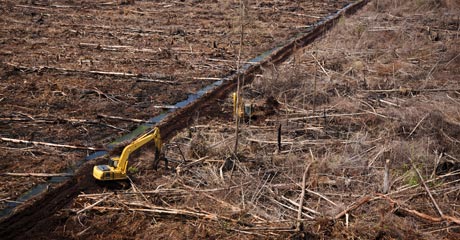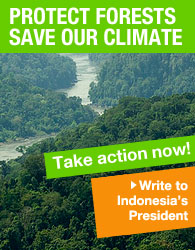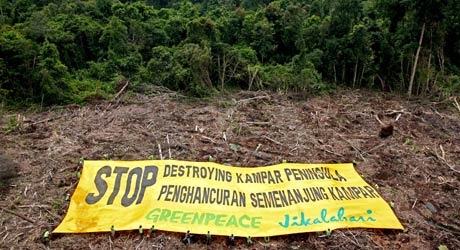
Backs against the wall: holding out the banner in the Kampar peninsula © Greenpeace/Novis
I’ve scrubbed and showered but there are still traces of mud sticking to me. It’s my own fault – I guess I shouldn’t have gone tramping around the peatlands here in Riau. But the picture above, that’s us: some of the Esperanza’s crew and several Indonesian volunteers pulling our banner tight against the forest wall, the straight line that separates the thriving ecosystem from the barren areas which have been cleared of trees. In case you’re wondering, I’m at the top of the P in ‘STOP’.
It was an early start and a long drive to get to the site on the Kampar peninsula, chosen because PT Arara Abadi-Siak has permits to set up plantations for acacia trees, used for making pulpwood and paper. The company is a subsidiary of Asia Pulp and Paper (APP), which is in turn owned by our old friends Sinar Mas – as well as having fingers in pulpwood, Sinar Mas is also one of the largest palm oil producers in Indonesia (not to mention a member of the Roundtable on Sustainable Palm Oil), and many of the nearby palm oil plantations have their name above the gate.
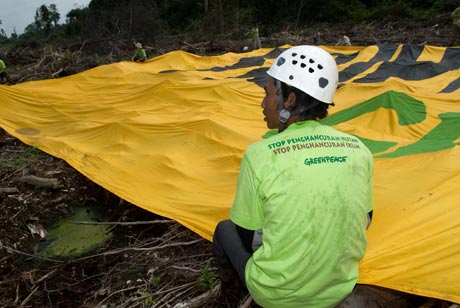
Holding on to the banner © Greenpeace/Sharomov
Driving along the road from Sungai Pakning was deceptively pleasant – elegant wooden houses were nestled amongst lush green foliage, and kids were cycling to school. But after crossing the Siak river on the ferry, we were deep into plantation country. Rows of oil palms lined the way with their shaggy coats of ferns, and bunches of palm fruit lay by the roadside. Along one stretch, intact forest sprawled to the right while regiments of young oil palms were springing up on the left, the forest wall a thick blue line on the horizon, and a pipeline followed us all the way from ferry.
The chosen spot was a few hundred metres from the dusty, potholed road so we had to clamber over some rough terrain to get there. Dead tree stumps and rutted ground lay in our path, not to mention the swampy bogs I fell into more than once. By the time we’d finished, most of us were covered up to our knees and beyond in thick black mud. Amongst all this, acacia saplings were growing in place of the forest that once stood there.
Manoeuvring a banner of that size (40m by 20m) is no mean feat, and it took 20 of us to unroll it and pull it into shape. While we were waiting for the photos to be taken, I had a proper look around. The forest wall was just 20 metres behind me, a dense jungle of bark and foliage. I really hoped I’d get the chance to wander in, even just for a few minutes – sadly, it wasn’t to be but the whooping cries of birds and the endless insect thrum carried across the wasteland. The peatlands are a fantastic place for wildlife with one of the highest rates of biodiversity in Indonesia, and some of it came to visit us by the banner. Long, slender dragonflies and giant butterflies swoop over canvas, and a swarm of lazy green beetles seemed particularly attracted to me. It must have been the sweat dripping from me (no really, they probably drink the stuff).
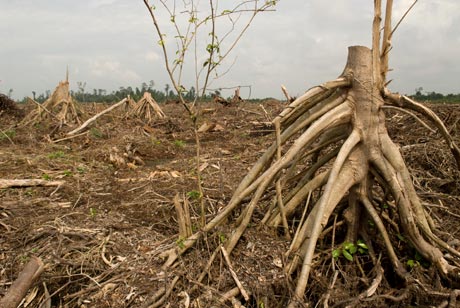
A graveyard of roots © Greenpeace/Sharomov
In front of me, it was a different story. A wasteland of greys and browns, with root systems upturned and exposed to the air, and buttress roots abandoned by the trunks they used to support. In the distance, another forest wall rose up, a small island of green hedged in between the road and the wasteland, but who knows how long it will survive. Both that tiny wedge and the forest you see in the image above also fall within PT Arara Abadi-Siak’s concession; they just haven’t been destroyed yet.
The name Jikalahari which appears on the banner alongside Greenpeace belongs to an umbrella network of various organisations dedicated to sustainable forest management in Riau, interwoven with the rights of local and indigenous people. Greenpeace campaigners in Indonesia have worked closely with Jikalahari and yesterday we held a joint press conference on the ship. The purpose of this was to reiterate our demand for a nationwide moratorium on deforestation, and support someone who’s already trying to put on in place.
Wan Abubakar, the governor of Riau, has made a decree for just such a moratorium in his province. It needs the national government to formalise it before it can be enforced, and both Greenpeace and Jikalahari are trying to make it a reality by mapping out the forests and plantations of the Kampar peninsula, which is what many of our recent helicopter flights have been in aid of. With these maps, we can establish which areas need protecting and which could potentially be restored, and of course a moratorium in Riau would lend extra pressure to a similar one across the country.
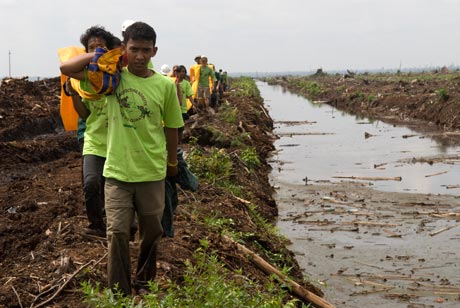
Carrying the banner alongside a canal draining water from the peatlands © Greenpeace/Sharomov
But back in the field, we had the banner rolled up and halfway back to the road before the company security guards caught up with us. They weren’t keen on having their photos taken, but of course had their camera phones trained on us the whole time. After some skilful negotiation on the part of our campaigners, we were escorted out of the plantation and headed back to the ship, grubby, tried and happy.
But I still can’t help thinking about the wall of forest which towered behind me, and how long it has left.
posted by Jamie on board the Esperanza






